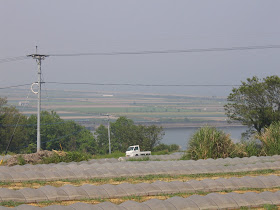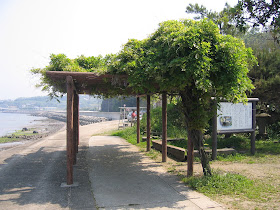Okay, so we’ve finally got Shoko’s digital camera up and running now, which will hopefully give these “Better Know a City”s post a little more color. I am slightly worried though (as everyone who returns from vacation bearing pictures always is) that the pictures don’t really do justice to the landscapes. I was absolutely overwhelmed by the beauty of this place. Especially in the morning when the sun was sparkling on the ocean, and the mountains reflected the deep green of late spring. (In the afternoon it clouded over a bit, and the colors didn’t strike me quite as much). The Japanese countryside in Kyushu can be a breathtaking thing, especially when the green from the mountains comes right up next to the ocean, and the rice fields and houses are squeezed somewhere in between the two. I’m not sure this quite comes out in the pictures, but I guess this is still probably better than no visuals at all.
I had driven through Matama a few times before, but I never explored around in it. So the first thing I did was to drive down the main street, and go into the town hall. (Actually since the town mergers, Matama is now technically part of Bungo Takeda, but they keep a branch open in Matama). I looked through some of their pamphlets, but I couldn’t find any brochures on Matama. There was a brochure on the new incorporated Bungo Takeda, but all the old town lines had been taken off the map, and it was hard to tell where the old Matama boundaries used to be. (Fortunately they still left a lot of the street signs up, so when I’m driving around I can still kind of get an idea).
I went up to the front desk and asked where the good sight seeing areas in Matama were. Most of these country towns don’t get a lot of tourists, so they’re not used to being asked this question. The couple at the desk hemmed and hawed for a while, and then pointed out a few temples on the map.
Ah, the temple hikes. I may have already seen enough temples to last me a lifetime, but I guess if I’m going to continue to explore in the countryside, I better get used to it. And besides, stopping at a temple is just an excuse to admire the mountain behind it, and I have no problem with that.
But before moving inland towards the mountains, I wanted to explore the seaside a bit more. I may have lived in Japan for 5 years now, but 23 years in the mid-west is hard to undue, and I still feel like it’s a treat to get a view of the ocean.

My students tell me that the Matama beach is rated one of the top 100 places to view a sunset in Japan (and the brochure confirms this). Who decides these things, and what the criteria is I don’t know. I’m highly skeptical that anyone could objectively pick out the best 100 sunset spots in a country. I mean, even if you did a sunset tour of all of Japan, wouldn’t your opinion always be influenced by what the sunset was like the previous night, and not by objective criteria? But these kind of rating systems seem to be very popular in Japan. My old town of Ajimu has one of the top 100 waterfalls of Japan.
Since I left for home at 5pm, I didn’t stay for the sunset. (Hey! I’ve got a life to lead, and besides, viewing the sunset by myself wouldn’t have been any fun. I might have to come back with the girl one day). I did get a few pictures of the view around 11 AM ish. Just imagine the sunset part yourself.
I found some paths and hiked up a couple different hills to get the view of the Ocean and the rice fields below.


Although I think one of these paths was only created to make a way for the power cables, I was still struck by how full the plant life is in the spring, and how many different shades of green were crammed into the same mountain. I’m not sure the picture below really does it justice, but as I did not take pictures of all the other paths I hiked this day, this one will have to stand for all.

One of the mountains went right up against the ocean, and there was a tunnel going through one of the mountains. I had driven through it several times before, but they also had a separate tunnel for pedestrians (mostly school children I suspect, as there was a school just on the other side of the tunnel). Since I had the car stopped anyway, I decided to get the whole school child experience and walk through the tunnel, even though I knew perfectly well what was on both sides. (The same instinct that makes me climb up every path I see sometimes also gives me the urge to walk through every tunnel. I don’t know why).

After I felt I had explored the coastline thoroughly, I went inland towards the mountains and followed the signs for the temples.
First stop was a little park that had been created around one of the mountain rivers. As it was a weekday afternoon there was no one there, but they had a whole “Michi no Eki” set up. (Translates roughly as “Road station”. Kind of little tourist traps all over the Japanese countryside selling ice cream and countryside vegetables, usually along a nice river with a view.) They had a little grass park, and cute little bridges going over the river, and lots of wild flowers. Very nice. Spent a while walking around there and following the river.

Then back in the car. I followed the signs up the mountain for the “Stone circle”.
There is a stone circle in Ajimu as well. I never really understood the point of it, although I hiked it several times on days when I was bored. It’s a really steep path going up the mountain, and when you get to the top, there’s just a bunch of large rocks. And a bit of a view, but given how long the hike is, the pay-off from the view is nowhere as good as it should be. I guess big stones on top of a mountain must have some sort of significance in Japan.
I expected this stone circle in Matama to be more or less the same as the one in Ajimu, and it was. I parked the car, I spent probably an hour hiking up the mountain, huffing and puffing and sweating bullets and all that, fighting the underbrush and batting away flies. And then at the top there are just some rocks with a straw wreath around them.

And a bit of a view from the mountain. Probably not worth the work it took to get up there, but I could use the exercise and I was looking for a good hike. (Again, these pictures don’t really do it justice. In reality I could see all the way to the ocean from the top.)


There were a number of other paths branching off from there. I followed most of them around. Saw some other temples, some of them almost covered by the forest.

Some of the paths were just dead ends. I always feel like I’m missing something if I don’t follow a path to the end, but after about another hour I decided I had gotten my hiking quota in for the day, and was ready to see something else.
Drove along the mountain roads of Matama for a while more and took in some more temples. I didn’t take pictures of everything, but even though some of these temples were more interesting than others, the mountain roads leading up to them were always gorgeous.
Around 4 PM I was feeling all templed out, so I decided to make one last stop and then call it a day. I looked at the map, and decided to go down to the lake created by the Namiishii dam. (I’m not entirely sure this last one is within the boundaries of Matama. Like I said above, it’s getting hard to tell since the town mergers. I like to stay consistent on this project, but in the end there’s probably a limit to how much one can worry about this kind of thing.)
Environmental consciousness is a bit behind in Japan. While in the West the new shift is to keep things natural, and even undue some of our old dams, the Japanese still think of a dammed up river as a thing of beauty, and market it as a nature excursion. I remember once getting hold of a book that was being given out to the school children in Oita prefecture to help them appreciate nature and celebrate all the wonderful natural spots in Oita prefecture. I couldn’t believe how many dams popped up in that book as “natural beauties.”
But my high-horse liberalism aside, I’ve got to admit it is kind of beautiful to see these lakes in the middle of the mountains, even if they aren’t entirely natural. There was a path going around the lake, and I walked the whole thing just for the hell of it. At points I could look down from the dam to see the rice fields down below, which was a beautiful view. (There was also a park with watermills in it and a picnic stand, called “Greenland” although perhaps because it was a weekday no one else was around. And the ice cream stand was closed.)


Link of the Day
US-led forces admit civilian casualties in Afghan fighting


Nice pictures of Matama. The only place I've been to is the sunset viewing spot where there was a big wooden fort-like thing you could climb on. It was probably meant for romantic couples to enjoy the view, but we turned it into our playground.
ReplyDelete